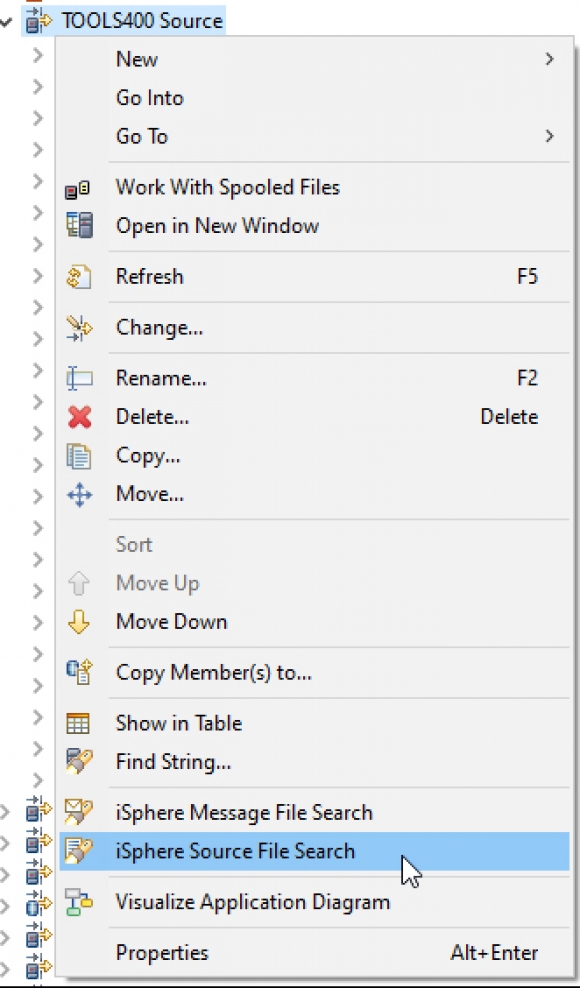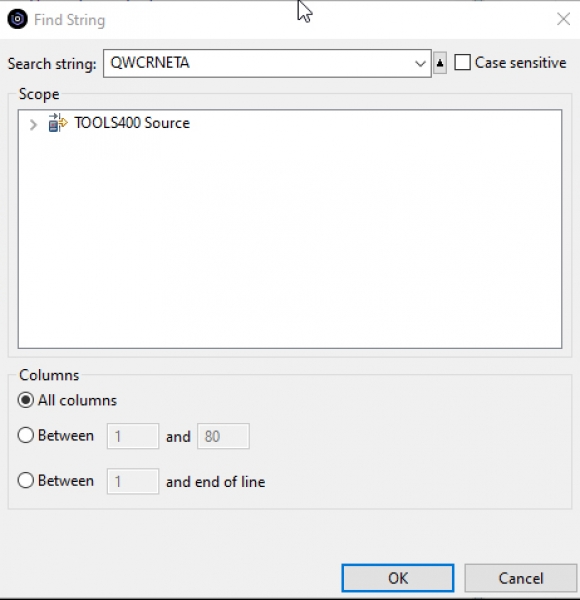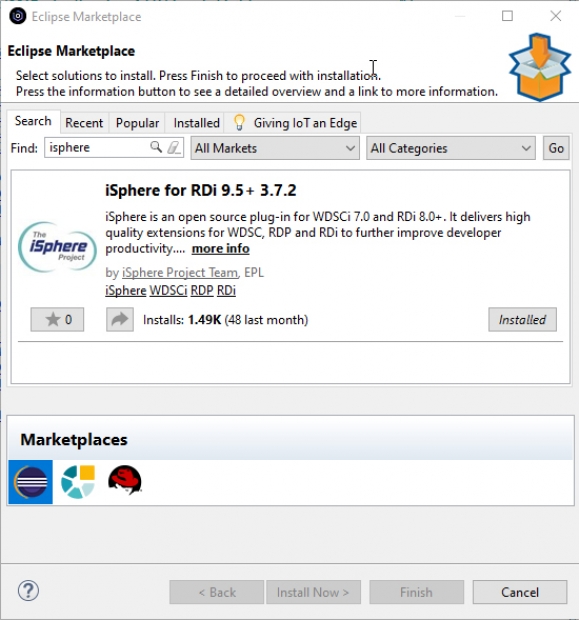iSphere brings together two worlds: Rational Developer for i (RDi) and open source.
I’m going to spend some time in upcoming articles introducing various open-source tools available for the IBM i. These will include purely IBM i utilities like Giovanni Perotti’s MMAIL, but also some that are specifically designed to interface with IBM’s RDi. This first article brings you one of the most robust integrations, Thomas Raddatz’s iSphere.
iSphere Source File Search, Find String, and a Whole Lot More
iSphere isn’t just one feature. In fact, I’ll probably have to write several articles to identify all of the things this incredible piece of software can do. However, the function I use the most by far is its search capability. iSphere builds on the Remote Systems view and is accessed much the same way you would access RDi’s native Find String feature.
Figure 1: Start by creating a standard RDi filter to get a list of source files.
If you’re unfamiliar with how a filter works, it’s a relatively straightforward concept but has many nuances. You can set up a basic filter quickly and easily, but you can also spend a lot of time creating complex filters to deal with specific cases. This is a relatively simple filter: I want to look at all the source files in the TOOLS400 library. (This particular library is a few years old, so if you’re playing along at home, your list might not match mine.)
Once set up, the filter then appears in my Remote Systems view, where I can now perform a mass action on the entire list of files by simply right-clicking on the filter as shown in Figure 2. You’ll see that I can select (among many other options) either Find String… or iSphere Source File Search. But the similarity ends there.
Figure 2: I can right-click on the filter and choose an option from the context menu.
Figure 3: The Find String dialog from RDi is very basic.
You can see that the dialog doesn’t give you a lot of options. You enter a search string and say whether the search is case-sensitive or not. You can limit the columns as well, which is nice but not something I use very often. If you hit OK, you’ll get a list of all the matches in a single window.
Figure 4: iSphere will build a list of all the source members and then you can execute your search.
iSphere builds the list of all members and puts up the dialog shown in Figure 4. It is very fast, especially for a single source file. With a broader filter like mine, which includes many source files, it can take a few moments to build the entire list, but it’s still pretty quick. Once you do get the list, that’s when the magic happens.
First, let me just run it as I’ve shown above. I am searching for CEETSTA. You’ll notice a few controls at the top; I think the defaults are what I have shown. As defined, this dialog is going to run a search with a single match expression that is case-sensitive and doesn’t use regular expression (we’ll cover regular expression in a moment). Basically, it’s just going to look for the string CEETSTA in uppercase in all the members.
Figure 5: The search progress appears in a standard progress bar.
I just hit the OK button and the search begins, with a nice progress bar.
Figure 6: The results panel allows a quick navigation through the matches.
The results panel is also a big departure from the base RDi capability. Where RDi presents a single view with all of the members and instances together in a sort of tree, iSphere presents a header/detail view, where the members are shown in the left panel; as you click on those, the actual matches appear in the right panel. I find this easier to navigate, especially when some of the members have dozens or even hundreds of matches. Even cooler, though, are the icons on the upper right of the results panel, especially the little Excel icon.
Figure 7: You can export the results to an Excel spreadsheet.
This will create a spreadsheet with three panels, one with the summary, another with all the individual matching lines, and a third with the search criteria in case you forget what you were searching for and where. I use this at the beginning of every maintenance project to build a list of programs to review. One last topic for this introduction (and it really is just an introduction; the tool has much more in it): regular expressions. Let me show you how those work.
Figure 8: Selecting the Regular expression checkbox allows you to use regular expression syntax in your search.
This is an actual example of a regular expression (Regex) that I just used in a search. The business problem was that I needed to find references to any of the three email techniques that we use in our shop. Those include IBM commands SNDDST and SNDSMTPEMM, as well as the popular EML commands (EMLSMF, EMLMSG, and EMLSPLF) from Giovanni Perotti’s MMAIL package (which I referenced at the beginning of this article). I was able to search for all of them using a single expression. So the syntax I used was the “or” syntax in Regex, which is multiple terms enclosed in parentheses, separated by vertical bars. (A|B|C) means A or B or C. Mine had three terms:
- SNDDST
- SNDSMTPEMM
- EML(STMF|MSG|SPLF)
You’ll notice that the third term itself had an embedded Or clause, which then expanded it to search for EMLSTMF, EMLMSG, and EMLSPLF. So when this search is actually executed, it will match any members that contain any of five values: SNDDST, SNDSMTPEMM, EMLSTMF, EMLMSG, or EMLSPLF. All of that from one little expression.
Regex is a wonderful technology, and I highly recommend learning it. It is not, however, for the faint of heart. The syntax is compact and powerful, but that makes it, to me, difficult to decipher at times. The good news is that there are powerful online tools to learn Regex syntax. My favorite is RegExr, but there are others. Trust me, if you have the time, this is a good thing to know.
What Really Makes This Special
The truly amazing part about iSphere is that it’s open source. That has a number of incredible benefits. The most obvious is that it’s free, which is especially important for smaller shops. You’ve seen what it can do, and the only investment on your part is the time to install it, which Thomas has actually made about as simple as possible. If you’re interested, let me know in the comments and I can go over installing and upgrading in more detail in a subsequent article. If you can’t wait that long, just look for it in the Eclipse Marketplace (from the RDi main menu, Help > Eclipse Marketplace…).
Figure 9 Use menu option Help > Eclipse Marketplace… and enter iSphere in the Find: field.
But potentially even more beneficial is the fact that all of the source is available, which is an extraordinary opportunity for anyone looking to expand their skill set. The code uses a wide range of advanced programming techniques, and it extends across the platform bridge from the IBM i to the Java world of RDi. If you want to see some real-world examples of high-level technical programming, iSphere is the place. This article is an example of just that: I used iSphere to search the TOOLS400 source for example of using the CEETSTA API. That is a win on a win! So, get iSphere installed, use it, and if you want to learn how to code, dig into what Thomas has provided.
As a final note, Thomas has a rather low-key donation page on his site. I think it’s a great idea to send him a few dollars; I know his work has saved me a ton of time. I’m embarrassed to say I never donated until I was writing this article. As I introduce other projects, I’ll try to find a donation link for them as well.


























 Business users want new applications now. Market and regulatory pressures require faster application updates and delivery into production. Your IBM i developers may be approaching retirement, and you see no sure way to fill their positions with experienced developers. In addition, you may be caught between maintaining your existing applications and the uncertainty of moving to something new.
Business users want new applications now. Market and regulatory pressures require faster application updates and delivery into production. Your IBM i developers may be approaching retirement, and you see no sure way to fill their positions with experienced developers. In addition, you may be caught between maintaining your existing applications and the uncertainty of moving to something new. IT managers hoping to find new IBM i talent are discovering that the pool of experienced RPG programmers and operators or administrators with intimate knowledge of the operating system and the applications that run on it is small. This begs the question: How will you manage the platform that supports such a big part of your business? This guide offers strategies and software suggestions to help you plan IT staffing and resources and smooth the transition after your AS/400 talent retires. Read on to learn:
IT managers hoping to find new IBM i talent are discovering that the pool of experienced RPG programmers and operators or administrators with intimate knowledge of the operating system and the applications that run on it is small. This begs the question: How will you manage the platform that supports such a big part of your business? This guide offers strategies and software suggestions to help you plan IT staffing and resources and smooth the transition after your AS/400 talent retires. Read on to learn:
LATEST COMMENTS
MC Press Online